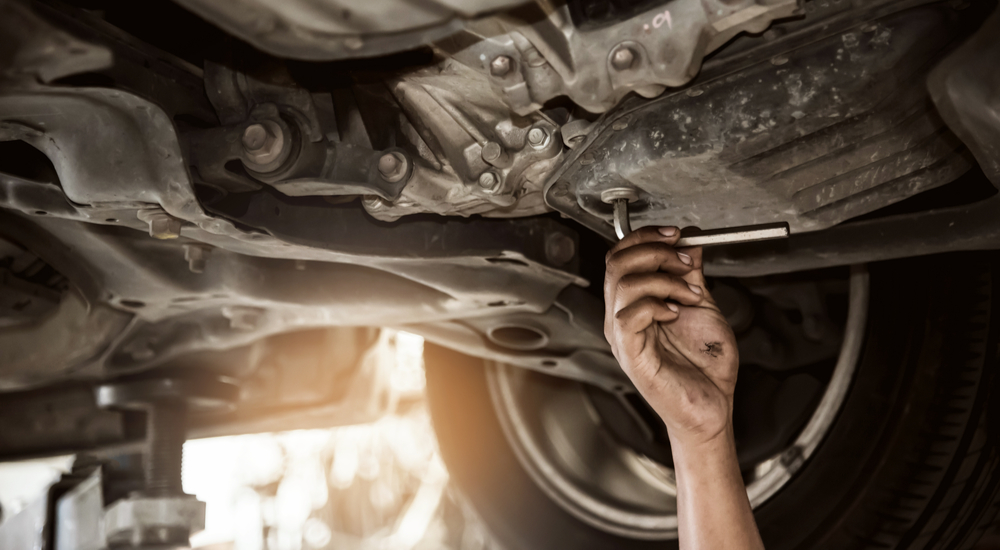One of the most tedious parts of car ownership is the regular oil changes required to keep your vehicle in good running shape. Driving over to a service center means precious dollars and time spent, all for a process that takes mechanics all of fifteen minutes to complete. It makes you want to try it yourself at home, right? Changing your vehicle’s oil is a relatively simple procedure, but it does require lifting the vehicle somehow (unless you’ve got enough ground clearance to give you room to work), getting underneath your car, and draining the oil out in a way that doesn’t result in you or your floor being covered in oil. Again, tedious. Something that can make the process less tedious and more tidy is the installation of an oil drain valve. If a quick oil change at home is the route you want to go, it may be worth considering installing.
What Is an Oil Drain Valve?
Oil drain valves are small valves that take the place of the drain plug on an oil pan. There are a number of different designs, but all essentially involve loosening or tightening the valve to drain the oil pan or seal it off. Instead of unscrewing a plug and getting oil all over your hands (amongst other places), you can easily open and close an oil drain valve for a cleaner, more controlled drain. They come in all different sizes to fit different vehicles and oil pans, and the manufacturer of the oil drain valve will have information on which vehicles their valves are compatible with.

Brands
Before purchasing an oil drain valve, familiarize yourself with some brands so that you know which valve will match your quality and budgetary needs. Four of the most well-known manufacturers of oil drain valves are Fumoto, EZ Oil Drain Valve, ValvoMax, and Stahlbus.
Fumoto: Japan-based Fumoto invented the first oil drain valve in 1976 and has since become one of the most trusted brands in the business. Several vehicle manufacturers, including Toyota, Nissan, and Subaru, have adopted Fumoto parts as OEM parts on their vehicles. Fumoto oil drain valves are designed to withstand everything your car can, especially high amounts of vibration and extreme heat. Fumoto specializes in oil drain valve accessories as well, such as the oil drain valve cover cap. It protects the valve from dust, dirt, and debris, keeping everything flowing smoothly.
EZ Oil Drain Valve: This company specializes in several oil drain valve products for cars, light trucks, and industrial vehicles. They offer optional hose ends for their oil drain valves, so users can easily attach and detach a hose to the valve, giving full control over where the oil drains. They have two different valve ends to accompany their hoses: the straight hose end and the L-shaped hose end. The latter has a 90-degree bend in it. These options allow users with different amounts of clearance around their oil pan to utilize a drain hose. One may be more convenient than the other, depending on the location of your oil plug.
ValvoMax: The ValvoMax Quick Twist Valve has a design reminiscent of a Nalgene water bottle cap. Instead of opening with the turn of a lever like the aforementioned valves, the Quick Twist has a cap that screws on and off and is attached to the valve via the rubber seal. ValvoMax offers a Drainmate kit for those who want the option of buying a bundle of gear needed for an oil change all in one go. Kits include the Quick Twist oil drain valve, 10-liter oil drain bag plus a hose, and funnels, amongst other things. ValvoMax is based in Texas and is veteran-owned.
Stahlbus: This German company has put its own twist on the oil drain valve. Its made of high-strength steel and copper sealing and includes a safety cap made of aluminum and a drain tube made of silicone. To use the Stahlbus oil drain valve, the user removes the safety cap and screws in the drain tube. To allow the oil to flow, the drain tube just needs to be rotated a quarter turn clockwise and vice versa to reseal the oil pan. The safety cap adds an extra layer of protection.
How to Install an Oil Drain Valve
As far as DIY auto maintenance goes, it doesn’t get much simpler than installing an oil drain valve. The whole process can be broken into two steps:
Step 1: Drain Your Oil
When installing an oil drain valve, you’re going to want to start with an emptied oil pan. Depending on how low to the ground your vehicle sits, you may need to lift it in order to access your oil pan. Ramps or jack stands both work great, and chock blocks behind the grounded tires will prevent the vehicle from rolling. You can never be too safe! Grab your oil receptacle of choice – bucket, oil drain pan, etc. – and position it under the oil pan so it can catch the drainage. Remove the drain plug (and revel in the fact that this is the last time you’ll have to get oil all over your hands when changing your oil at home). Once the oil is drained, clean off the oil port area, and you’re ready to move on to the next step.
Step 2: Installing the Oil Drain Valve
Installing an oil drain valve is as easy as screwing in a lightbulb. As long as you’ve got the correct size, the oil drain valve will thread into the oil pan in exactly the same way as the oil drain plug. Depending on the oil drain valve, there may also be a gasket that needs to be put on the valve in order to create a good seal. From there, make sure the valve is closed, and you’re good to fill the oil pan back up with fresh oil.

Other Things to Consider
There are a few extra things to keep in mind when installing an oil drain valve. Make sure your valve of choice is compatible with your vehicle’s ground clearance. Some valves protrude from the oil pan more than others, which could cause complications if you have a low-riding vehicle. Whether or not to utilize a hose can affect your future oil changes as well. Will you be fine having the oil drain straight from the valve, or do you prefer to drain the oil away from the engine in a more controlled way? Be sure to have a game plan for disposing of used oil as well. Most auto part stores will recycle used oil for you; otherwise, it can be dropped off at your local Recycling Center or Hazardous Waste Drop Off.
Oil Drain Valves Make Life A Little Bit Easier
Although changing a vehicle’s oil – valve or not – is a fairly simple process, adding an oil drain valve to your vehicle makes it that much simpler (and cleaner). If you’re a person who performs regular maintenance on your vehicles at home, the time saved and messes spared with the inclusion of an oil drain valve will have you never looking back.

